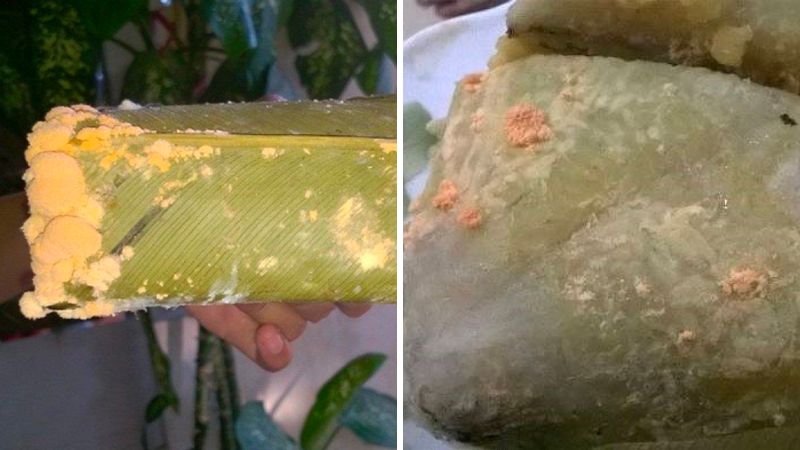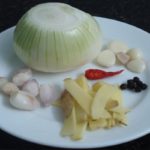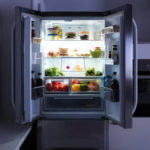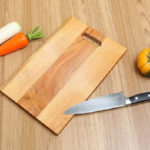Sticky rice cake is a traditional delicacy that is often enjoyed by families during holidays. However, if not stored correctly or left for an extended period, the cake may develop mold.
Is it Safe and Healthy to Cut Off Moldy Food and Eat the Rest?
Many individuals possess the mindset of minimizing food waste by removing the moldy portion and consuming the unaffected remainder. Nonetheless, it is imperative to evaluate the safety and health implications of this practice.
So, is it really safe and beneficial for your well-being? Let’s delve into the subject to gain a comprehensive understanding.
Is it Safe to Eat Sticky Rice Cakes With Moldy Leaves or Corners?
The sticky rice cake is a high-moisture food because it is wrapped in dong leaves and cooked through boiling or steaming. Additionally, it often contains various fillings which further contribute to its moisture content. As a result, the sticky rice cake is susceptible to bacterial and mold growth, particularly in the hot and humid conditions commonly found in our country.
It is important to consume fresh and properly cooked sticky rice cake to avoid any potential health risks. Eating rotten, sour, moldy, or runny rice cake can lead to unpleasant symptoms such as stomach pain, diarrhea, and even food poisoning.
 Bánh chung bị mốc lá, mốc một góc
Bánh chung bị mốc lá, mốc một góc
According to Master, Doctor Nguyen Van Tien, Center for Nutrition Education and Communication, National Institute of Nutrition:
“Cakes that are moldy, sour, watery, or bitter must be discarded. For cakes that have a small amount of mold on the outside, it is advisable to cut a wide area around it, taking only the intact part of the cake, and to carefully steam or fry it before consuming.”
To ensure utmost safety for your health, it is highly advisable not to consume sticky rice cakes that have moldy leaves or corners. Mold can generate aflatoxin toxins which can permeate into the cake. Additionally, even when the mold is no longer active, it can still emit other harmful substances that are detrimental to your well-being.
Preserving Sticky Rice Cakes to Avoid Mold and Spoilage
According to Assoc. Prof. Dr. Nguyen Duy Thinh from the Institute of Food Technology at Hanoi University of Technology, it is recommended to only wrap a sufficient amount of cakes that can be consumed by the entire family during the Tet holidays. It is advised not to wrap an excessive number of cakes that may not be eaten in time, as this can lead to the growth of mold and spoilage.
To ensure optimal preservation of sticky rice cakes, you can utilize the following techniques:
- If stored at room temperature, it is recommended to keep the cakes in a cool, dry place to ensure they stay fresh for 3-4 days. However, please note that if the weather is humid and wet, the storage time may be shorter.
-
Store the cake with intact leaves in the refrigerator. When ready to serve, cut the desired portion and wrap the cut part with cling film. With proper storage, the cake can be preserved for 7-10 days.
- To ensure hygienic storage, it is recommended to vacuum seal the cake. Doing so will extend its shelf life to 5-10 days under normal conditions, and up to 15-20 days if refrigerated.
- For optimal storage, it is recommended to store the cake in the freezer. When ready to eat, slowly thaw the cake by placing it in the refrigerator for a few hours. To maintain its texture, steam or boil the cake again before consuming.
 Cách bảo quản bánh chưng lâu mốc, lâu ôi thiu
Cách bảo quản bánh chưng lâu mốc, lâu ôi thiu
For further information:
For the sake of your health, it is advised not to consume sticky rice cake if it shows signs of mold. Your well-being is of utmost importance to us, and we genuinely hope that the information provided above proves valuable to you.
More Useful Advice for Homemakers (Part 2)
Have you heard of the surprisingly easy tips to make cooking and household chores simpler? White radish eliminates the acrid taste of salted meat, adding alum to raw shrimp helps soften it, and adding cold water when frying eggs can make them crispy – these are just a few of the tricks to make your life easier.
8 Common Mistakes People Make with Cutting Boards
Are you using your cutting board correctly? Many Vietnamese households rely on cutting boards in their kitchen, but not everyone knows how to use them properly, especially when it comes to wooden cutting boards. Check out these 8 mistakes to avoid when using a cutting board to ensure both hygiene and safety for everyone in your family.






































